A list of all resources used in the making of this project:
BOOKS (more…)
A list of all resources used in the making of this project:
BOOKS (more…)
The Photographer II
It has come to my attention that photographers are rarely found on the opposite side of the camera; as the sitter for a project rather than for use as a document. As the media increases, we have developed a need for more information on those around us, including knowing the identity of someone.
With the initial idea from the series Behind Photographers by Tim Mantoani with other inspiration gained from the Sky1 Arts series Capture, I have aimed to capture the identity of amateur photographers, such as my peers. Photographs have been captured in sharp detail, particularly in the eyes; the key to seeing and the making of a photograph, while exploring who the photographer is within a single photograph. It can be noted that key influences have included the close up headshots of Thomas Ruff and Martin Schoeller. The start of the project began by looking at the use of using the photographers as the sitter with their camera as a literal nod towards their identity as a photographer, taking different approaches and understanding the limits of the Mamiya 67 Medium Format camera, to then overcome any obstacles such as the view finder on top. The idea expanded to the simple, single portrait of the photographer without any props, subsequently removing the distracting idea that the camera is the only thing that defines the photographer.
Only a fraction of the reality and personality can be achieved within a single image. With perseverance and experimentation of props and expressions expressed by the sitter, the ability to capture a raw portrait of a fellow photographer has been enabled. The dull, detached stare of the subject, in recognition of the camera, allows for the eyes to be a window to the soul; the start of seeing the true identity of the subject. A journey of the unknown has been undertaken for this final image. With limited possibilities of expressing the identity of a person, particularly in a direct portrait which defines the image in which they appear, revealing the character of the sitter becomes a challenge, working with the still image and no words. The portrait is one which forces the viewer to ‘read a book by its cover’, yet the ideas upon the identity become monotonous.
This project has been a journey into defining what a portrait truly is while experimenting with the idea of putting the photographers in front of the camera and being seen rather than always being hidden behind the camera when the only times they are recognised is when they are with a piece of work as documented by Tim Mantoani, the initial kickstart to this project.
The photographs produced in this series have been varied while having to understand and work with a Mamiya Medium Format Camera, a new experience in terms of camera and developing methods. Getting used to the camera was the first step in this project to which the pros and cons needed to be figured out, such as the need to be careful with each photograph captured while needing to manually change the shutter speed and aperture when the light changed. With the view finder and focus at the top of the camera, the height at which the camera needed to be placed had to be reasonable and a challenge unless a stepladder, chair or other height changer that I could sit/kneel or stand on was available. This was a limiting factor on some shoots but can be used to the advantage of keeping the perspective similar when producing a series of images or keeping a similarity and open choice of expression.
As the project developed the backgrounds and sitters varied depending on the availability and willingness to be put in front of the camera. The final prints convey different personalities and openness towards being in front of the camera with the more confident in front of the camera having expressions that may not be sincere towards who they really are as a person and a photographer. Tutorials along the journey have enabled the approach towards this project to differ and be approached in new ways to capture the essence of the photographer/person held within the frame.
The final print that has been produced is one which can be defined as having taken a journey to produce while being ‘technically perfect’ (by my opinion) whilst being raw in the expression and feeling evoked. The feeling is one which is undefinable and intriguing causing a stop and explore of the image and character expressed to which explores the emphasis upon the identity of the sitter.
With more time and availability of amateur (peer) photographers, I feel that this image could be the start of many, with knowledge of how this image has been captured which can be translated into other shoots. The way in which some shoots had been approached did not convey the same effect as the final outcomes, possibly due to an uncertainty in what I wanted to gain from the shoot even though the final image was idealised earlier in the process, the method in which to produce this was not as efficient. On reflection, I feel that a successful journey has occurred to produce a final print that I am happy with and would happily name as my own.
To conclude the series of photographs looking into who the photographer is, I decided to take the advise from Thom Atkinson to look into portraits that do not have the use of a camera a prop within the photograph. This idea is powerful in understanding who the photographer is behind and without the camera at hand. As a result of a successful print close to conveying the sense of scraping away the barrier to who a person is, I decided to use a photographer I previously photographed in One with a Camera. I also used another photographer to contrast the appearance and feeling within the photographs.
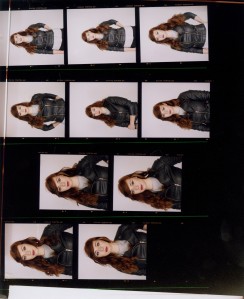
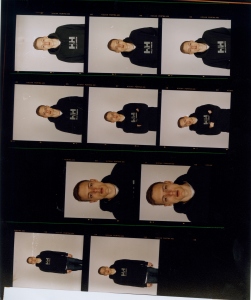
It has become clear that there is a preference towards the headshot style photograph which allows the face and eyes to become the vessel for the true character of the photographer to become clear as many quote “The eyes are the window to your soul” Unknown. In the contact sheet featuring the female photographer, a distance has been taken while a natural response towards being in front of the camera has influenced her positioning which has become a natural response even though it is a distortion of the natural stance before acknowledging the large camera in front of them. These images do not portray the same sense of understanding the photographer in a portrait into the soul.
The contact sheet at which my final print has been taken from, has been a development from a previous shoot of this peer photographer as the expressions are more relaxed and raw which questions the portrait being photographed while several incarnations of this print, both close and distant have been captured while the distance from the subject is more disturbing while cropping off the feet which may have been a mistake in terms of contrasting the composition while the distance is needed to capture the full body length which in turn, creates a distance to relating to the subject as they are further away, portraying a sense of intimidation.
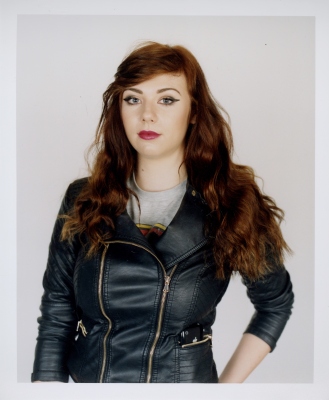
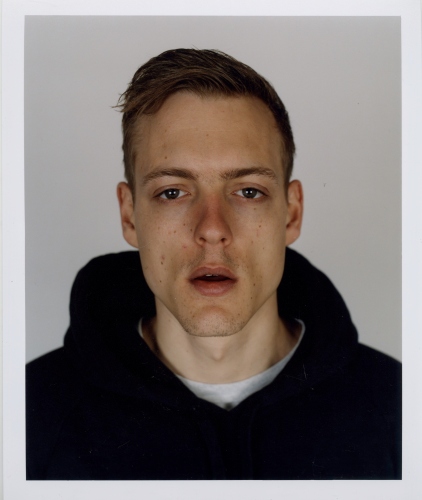
The Photographer II is to be used as the final print, drawing ideas of portraiture from Bettina von Zwehl, Martin Schoeller and Thomas Ruff. This photograph of a deadpan photographer is simple and sharp with a shallow depth of field. It is not a beautiful portrait but something raw and undefined allowing a focus to interpret who the photographer is by focusing upon the eyes and distant expression which is also expressing an attentiveness that is required by a photographer to get that perfectly timed photograph, even when slightly distant from reality.
Interesting thoughts came about from a tutorial feedback session today where looking at the overall series of photographs I have produced, the photographs vary in style and connotation with the smiling, holding the camera to the face produces images that are more representative of a still life image and ‘cheesy’ advertisements rather than the portrait of the photographer. The portrait itself does not need to be explicit in showing who the photographer is with the camera but one where the facade is removed and cut and the bare skin and person is shown through the photograph to truly portray the portrait of the intended photographer who is rarely seen in front of the camera.
Some of the photographs are great photographs of composition and print quality however do not produce the same effect of the portrait when removing such distractions and bearing the photographer under the skin.
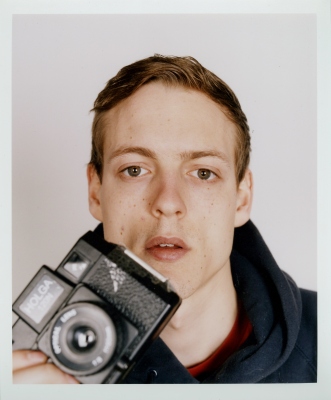
A possibility to take these portraits further is by looking at photographing from a distance as a full or half body standing photograph with the camera to become a smaller object within the photograph as a feature to relate to the subject of photography, symbolising their work as a photographer if they are standing naturally, off guard with the camera hanging loosely to the side of their body. Another idea is to simply remove the prop of the camera to portray the photographer as themselves as the overall subject rather than the subject with a camera which could be seen as overly literal and distract from the purpose of looking at who the photographer is.
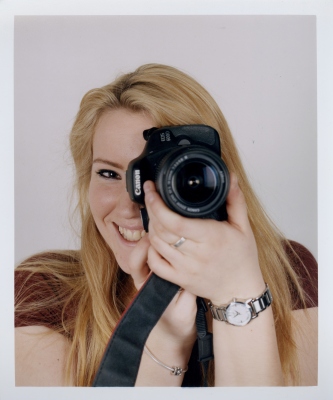
It has become clear that the work needs to focus upon clarifying the underneath of the photographer with or without the character without it becoming cheesy or unrealistic which is something much more difficult to produce when using a semi static camera that is completely obvious when changing focus and position when aiming for something that is more emotive and truthful to the photographer, getting a sense of the reality from both sides of the camera as photographers have a tendency not to appear in front of the camera for a variety of reasons.
To increase the possibility of more great portraits 3 rolls of film was used in an experiment shoot with a single photographer, looking at focusing closer within the frame while also trying 2 double exposures (even if the first was by accident – note: always check the multiple exposure is in the correct position before beginning). Using one flash and a black background has caused the background to become washed out in the first contact sheet although one successful print has been made by cropping into one of the images.
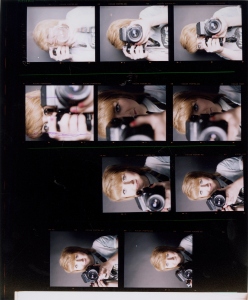
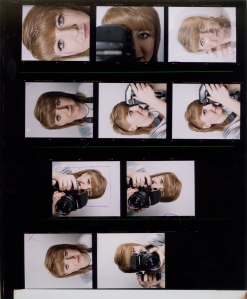
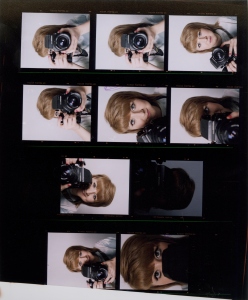
Although not all of them are perfect, some more successful in composition than others, the ideas used within the shoot have developed to confirm the use of the lighting while also showing that even when a photograph looks great with an interesting composition of cropping, the concept is not very strong in conveying who the photographer is but the opposite, showing the idea of hiding behind the camera rather than being shown in display for the camera. A range of compositions of close up portraits with the camera in different positions as to change the focus of the image. In some of the portraits, the camera becomes the main compositional element destroying any possibility of creating a connection to the photographer in the portrait. Figuring the single flash light with the composition became a challenge when paying more attention to what is being seen the lens than in reality as the lens image is flipped and therefore you think the lighting is on the right side of you and the sitter however you look up and realise you’ve created a shadow on the face from the camera being on the side of the light. casting a shadow on the other eye which is undisturbed by the camera.
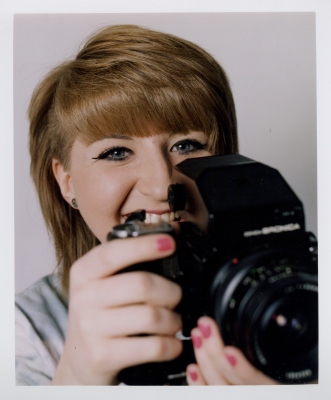
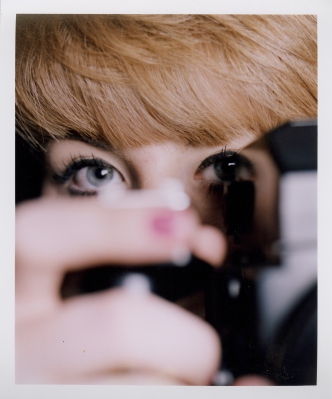
Hidden Photographer would have been much more successful as a print if the left eye had been in complete focus as there is a softness to the eye. If the eye was in complete and only the focus, then this photograph would convey a sense of looking into the eye of the photographer. The eye is a vital instrument in photography and a photographer would be severely disadvantaged if they did not have this tool.
Upon a search for photographers looking at the idea of photographing other photographers, I came across the work of Abe Frajndlich, born 1946, a United States of America resident after moving via Isreal, Brazil and France at the age of 10 from Frankfurt, Germany.
Frajndlich has created a series of work spanning over 20 years with over 100 different portraits of fellow photographers including the likes of Duane Michals and Annie Liebovitz in a series titled ‘Penelope’s Hungry Eyes’ as a reference to the wife of Odysseus who had a strong belief and patience for the return of her husband. The body of work seeks to uncover those who’s eyes are hidden by a camera, where Frajndlich has sought to discover and document his fellow photographers to discover and express what makes each photographer tick. Each photograph is personal to those within the photograph with setting, props and scenario changing in relation to how each photographer feels about being photographed or how they want to be perceived by other photographers and the public. Colour or black and white is a selective choice between the availability and the choice of the photographer being photographed as to portray a particular emotion/ idea across to the observer. The photographs presented are often subtly humorous, portraying a notion of creativity amongst photographers while the work responds to the similarities and differences, and also reputation of the person and the photographer (Frajndlich, A, 2013). The body of work has undergone several incarnations with publications at different times of the process with the series taking a form of Masters of Light, in 1991.
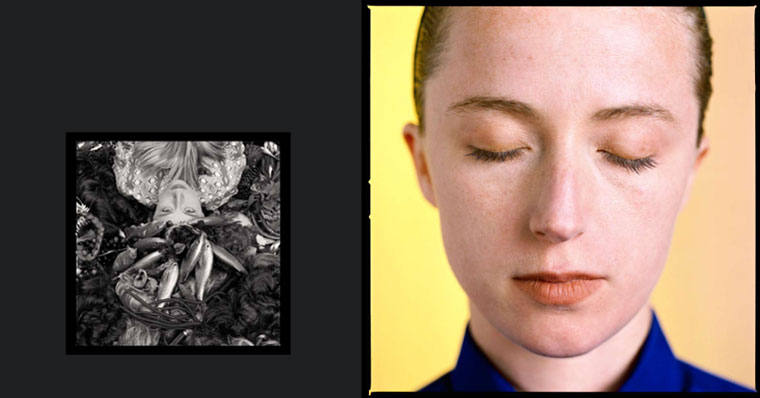
From the work of Frajndlich, a common theme is the choice of focus upon the eye of the photographer, the most valuable aspect of the photographer. Looking and seeing photographs is a key skill in distinguishing between photographs as we are inundated with photographs daily.
Frajndlich, A, 2013, Bio, [online] [accessed on 20/04/2015] Available from http://www.abefoto.com/bio.html
Frajndlich, A, 1991, ‘Photo ops with the masters’, Artnews,[online] vol 90, pgs 125-129 [Accessed 25/04/2015] Available from Art Source
Frajndlich, A. 2012, Photographing photographers, New York Times [online] 15 Jan. 2012 pg 7 [Accessed 25/04/2015] Available from Academic OneFile
Tregoning, B, 2015 PENELOPE’S HUNGRY EYES. [online] [Accessed 28/04/2015] Available at: http://www.tregoningandco.com/penelopes-hungry-eyes.html
Too further expand upon the idea of photographers and their cameras in front of the camera, I asked 3 different people to sit for me, all friends whilst within the studio, allowing for ‘banter’ and personality to show through in the photographs as the others in the studio are distracting from my task at hand, capturing the photographer for who they are.
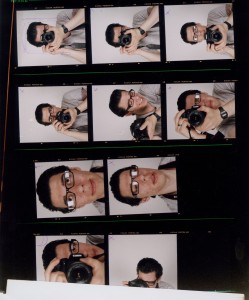
As a result of this, many of the photographs are varied and comical while some of the end results are extremely smiley and happy which can be perceived to be more commercial and less about the portrait of who the person truly is. The first contact sheet portrays portraits which are awkward in being unable to create a natural and approachable portrait where the approach to the photographs was unprepared. As the shoot changed sitter, I became more comfortable in the situation with the left contact sheet showing a more relaxed sitter over the energetic photographes produced in the right contact sheet. In some of the images, I purposefully made the sitters laugh as to create a lighter feeling to the photographs however this has produced portraits which have become more stereotypical advertising photographs of still life.
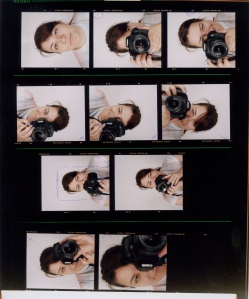
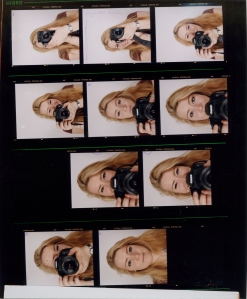
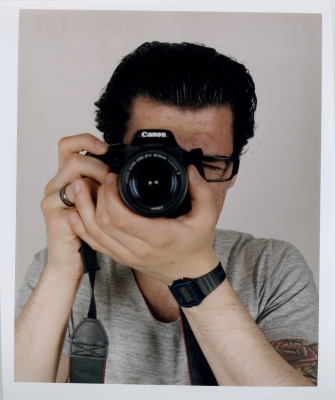

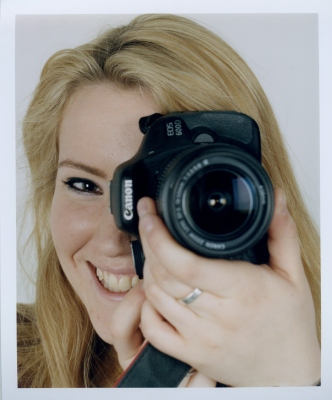
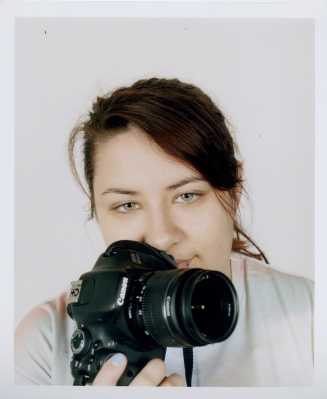
There is a clear use of inspiration from Martin Schoeller and his Close Up photographs while taking a step back to see more of the person and more of a clinical surrounding that is off-balance that is reminiscent of the work by Bettina von Zwehl. More experimentations with different people create different atmospheres within the photograph as to really get under the skin of a person in a portrait, more time may be needed in order to scratch away the initial appearance.
Portraiture is not an easy subject genre of photography if you want to portray something more than the everyday here is the person, oh and they are smiling. These photographs become more and more visible with ‘selfies’ and access to high-end camera’s enabling many to photograph themselves, family, friends and encounters with other people. The portrait is not just a matter of showing who someone is but truly looking closer and who they are, being able to feel an emotion, react to the image as a viewer.
In the article, What Makes A Great Portrait Photograph (2015) by Phillip Prodger, Head of Photographs at The National Portrait Gallery, the point of a portrait showing more than the subject as a still life but as something to convey emotions from both sitter and photographer as they dance uncertain of the move each other will make for that final photograph. An example of great portraiture used is of ‘Unknown Woman’ by Oscar Rejlander c.1863, presumed to be his wife.
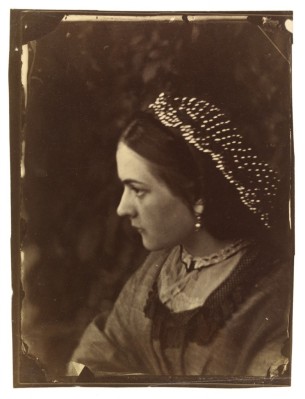
This photograph evokes the sense of love between both sitter and photographer leading to the presumption that this woman is to be his wife. The presence of this emotion is unknown in origin as the sensation could be as a result of the compositional aspect, printing tones or focus. There is an aspect to this photograph that is beautiful, yet would not cause just anyone to show this image as there is an obvious connection between the sitter and photographer.
In such great photographs, it is that which cannot be explained which make the great portrait. Seeing under the skin of the sitter is what draws us to the portrait, engages our mind to fully understand who this person is and what is their story, their significance to be photographed. With portraiture, and photographing another being the sense of knowing you are being photographed, inevitably causes subconscious reactions towards ‘posing’ for the camera at which point there becomes a point of wanting to evoke subtle gestures to express the personality which comes with a sense of inauthenticity towards the personality being shown (Barthes, R, 1993, pg 10,11,13). The very idea that the photograph has the ability to represent the identity is ambiguous with a static image in one particular frame when the identity is proven by motion and ideas by the person in the frame, not merely a single image of official validation(Clarke, G, 1992, pg 1). The portrait gives only the trace of the identity (Clarke, G, 1992, pg 3) , for a great portrait photograph, this trace needs to be strong with the implication by Susan Sontag that the direct portrait of a person discloses the soul of the person with a frank expression towards the camera (Clarke, G, 1992, pg 3).
‘It takes a lot of imagination to be a good photographer … it takes a lot of looking before you learn to see the extraordinary’ David Bailey (2014)
Prodger. P, 2015, What Makes A Great Portrait Photograph, [online] [Accessed 20/04/2015] Available from http://photoworks.org.uk/makes-great-portrait-photograph/
Bailey, D, 2014, Bailey’s Stardust, London, National Portrait Gallery Publications
Barthes, R, 1993, Camera Lucida, London, Vintage
Clarke, G, 1992, The Portrait In Photography, London, Reaktion Books
While previous research explored the profile photographs, the work of her early morning routine is which intrigues me most while has a great significance upon the movement in which my project is developing.
The series of work features her friends and acquaintances, captured at 5 in the morning with a sudden flash of light at a random moment of time (Zwehl, B, 2007, pg 70) Her subjects are placed in front of a white wall whilst wearing white clothing (Cotton, C, 2014, pg 31). Zwehl has developed a style of photography focused upon on exact conditions while allowing for the myriad of expressions in the unexpected flash (Zwehl, B, 2007, pg 10) She has been inspired in her recent works by being the Artist in Residence at the Victoria & Albert Museum for 6 months. (Purdy Hicks, 2014)
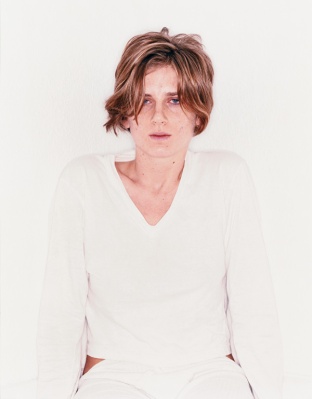
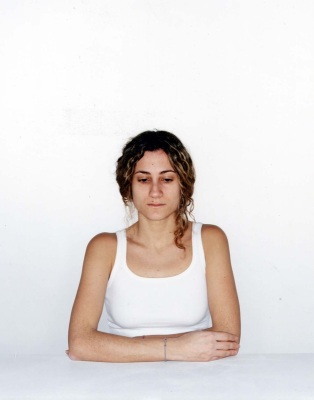
Using this technique, Zwehl has created several similar series of works where the sitter has been awoken at the unruly hour of 5am, to be photographed against a white wall whilst wearing white clothes when the subjects look red-faced, tired, hung-over, pale and vulnerable (Zwehl, B, 2007, pg 70). There are two similar projects, one where the sitters are perched on a stall while the other features the sitter at a table, smaller in the frame with their arms folded on the table. Each series is unnerving in the clinical aspects of white and exacting minimal conditions for each photograph, capturing those moments that people wish not to be seen. Each is uneasy in the whiteout appearance of the photograph, with facial expressions blank with underlying annoyance and sleepiness, expressing the unseen characteristics of the sitter which would not be achieved during full consciousness and complete knowledge of the camera and actions occurring around them. Distraction and lack of communication is a key theme as it is hard to fully read the portrait of the distracted subjects where reasons are not fully disclosed (Zwehl, B, 2007, pg 10) destroying any possibility of intimacy with the close subjects in the frame, depicting the subject as a specimen of a portrait, clarifying the clean uneasiness evoked. The subjects do not connect with the audience nor photographer as a result, creating unique portraits that define the aesthetics or concept of other portrait photography (Zwehl, 2007, pg 71)
Using the systematic approach to this series (Langford, M, 2008, pg 62), the work is able to be interlinked smoothly with the only changing aspect in the sitter to create a series that allows for the sitter to become the prime focus of the portrait as the background is washed out and has removed the distraction of props, colour and texture other than that found upon the sitter which is an interesting thought to portray the portrait that I wish to be able to convey.
Work has been published in many books whilst also having been exhibited globally from London to New York.
Cotton, C, 2014, The Photograph as Contemporary Art, Third Edition, London, Thames & Hudson
Zwehl, B, 2007, Bettina von Zwehl, Gottingen, Steidl
Langford, M, 2008, controlling the subject: Bettina von Zwehl, Source, Issue 54, pg 62-64
Smith, R, 2000, Bettina Von Zwehl, New York Times, 15 Sept. 2000: E33. [Online] [Accessed 25/04/2015] Academic OneFile
Purdy Hicks Gallery, 2014, Bettina von Zwehl, [Online] [Accessed 25/04/2015] http://www.purdyhicks.com/display.php?aID=17
Zwehl, B, 2015, Bettina von Zwehl, [online] [Accessed 25/04/2015] http://www.bettinavonzwehl.com/